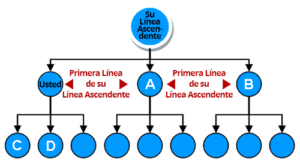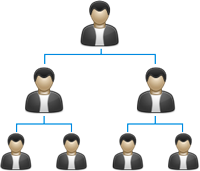In the previous article, we explained How to Understand Multilevel Marketing and how to grasp this business model. In this article, we explain the Basic Fundamentals of Multi-Level Marketing that are useful to understand this business model and then apply them to the TecnoCommerce MLM e-commerce platform.
MLM Matrix (Forced Matrix)
Of all the MLM compensation plans, the matrix model (also known as a forced matrix) is probably the simplest to understand. It starts at the top of your matrix, and as it grows, your organization fills the assigned positions below you (like an organizational chart).
Of course, there are slight variations that can be applied to the matrix model, but in general, the functionality is practically the same. As your organization grows, the levels of your matrix increase, and these levels provide you with residual income. This residual income is paid through commissions from product sales or recruitment achieved in your organization.
The basic matrix model for an MLM compensation plan involves two size factors, A x B.
- A (Children Limit): It’s the first level and the number of levels in the matrix. It consists of members you personally recruit into your organization.
- B (Matrix Depth): It’s the number of levels deep in the matrix. Some compensation plans limit this number, while others do not.
The standard MLM compensation plan matrix looks like this:

Example of a Fixed Matrix
The above is a 3X2 matrix (2 levels deep and three levels wide) and is a simple example.
More complex matrix models can extend infinitely in both width and depth, or they may have size limitations to trigger a matrix cycle or limit commission payments.
The two major variations in matrix models are whether the matrix is fixed or not.
Fixed Matrix Model
The fixed matrix model places limitations on the standard matrix, usually in the form of size restrictions. Typically, there will be a limit in the form of A x B to trigger a cycle event.
A cycle is what happens when the matrix fills up, and it usually involves the person at the top of the matrix “cycling” and being rewarded with a commission payout.
After cycling, the member is placed in another existing matrix within the company or at the top of a new fixed matrix. From here, the member attempts to fill the matrix again for another commission payout.
Fixed matrices generally have size limits, often in small numbers (2 x 3 or 2 x 2 are quite common) to reward regular commission payments for those who recruit heavily into the business.
Due to the nature of the fixed model, it is commonly affected by what is called “spillover.” We’ll explain spillover a bit later, but the essence of it is that the matrix can fill more quickly from the work of your upline or those above you in a fixed matrix.
Due to these limitations, matrices fill up and new matrices are started, which is why this fixed matrix model is also known as the “Breakaway Model.”
The Breakaway Model is the most common within MLM business schemes. It relies solely on a team of distributors “breaking away” to form their own groups when they achieve a certain level of success.
Almost all major MLM companies use some form of the breakaway pattern. Its dependable structure is highly successful for dedicated distributors.
Within the breakaway model, there are two groups of distributors: Marketers and Marketing Leaders. Each is paid different types of bonuses and various commission scales.
Starting as a Marketer, the associate can advance and, as they do, they could earn more. Once they have reached the point where they would qualify for the full differential bonus, they can “break away” and start their own team (new matrix).
When they have achieved the breaking point, their only way to earn more money is to become a Marketing Leader.
Depending on the company, the associate may have as many people as they want on the first level of their business, also known as their baseline. This will help boost their commission.
This model is complex, so you will likely need to employ some marketing strategies to help you succeed. You’ll want to add members to your downline so you can generate more income. By doing this, you pass on the position to help your guests see the benefits of joining.
Marketing will also help you succeed more in deliveries.
What Is Spillover?
When a new associate joins an MLM company with a fixed matrix compensation plan, they are placed at the top of a new matrix. However, this matrix is a branch of their upline’s matrix, which in turn is a branch of their upline’s matrix.
Spillover is what happens when someone located in a higher matrix above the associate in question fills a spot in their matrix, which in turn corresponds to a spot in the downline in the associate’s matrix.
Let’s say, for example, that the associate is in the first level of their upline’s fixed matrix (their leader), and their upline (leader) fills that first level. The next level down (the first level of the associate’s matrix) can be filled over time through the recruiting efforts of their upline (the leader), thus filling the other levels of the associate’s own matrix without the associate making any effort.
Here’s an example:

Example of Fixed Matrix Spillover
In the above matrix, you can see how the associate’s own matrix (referred to as “You”) fits with their upline’s matrix (Leader). For spillover to occur, let’s assume their upline (Leader) has filled their corresponding first line (points A and B), where they are located.
Let’s assume the associate (You) directly recruits someone for position C, and then their upline (Leader) manages to recruit another member. Since the leader’s first line is full, the available spot downward is in the associate’s matrix (You), so the spot gets filled at point D, from their upline (Leader). The filled point D affects both their own baseline and their upline’s matrix (Leader).
This effect is called spillover and doesn’t require any effort from the associate in question (You) to fill a spot in their own fixed matrix. This isn’t good for maximizing everyone’s effort.
Advantages of the Breakaway or Fixed Matrix Model
This model is stable, having existed for over 50 years. This reliability provides peace of mind as well as the highest potential earnings of all available MLM business plans.
This model is also guaranteed to be safe and not a scam. It has been observed by regulators at the state and national levels in various countries.
Disadvantages of the Breakaway or Fixed Matrix Model
While it is a successful model, the breakaway plan has its drawbacks. The payment method is one of them.
Payments are usually sent monthly and often take weeks to reach the associate. This means you will go through long periods without seeing any income, which can make it difficult to keep motivated.
This plan tends to have monthly volume requirements, and if they are not met, you will not get paid. It is also more challenging to convince others to join this type of plan. Its complexity makes it difficult to explain to people who are interested in joining.
Standard Matrix Model
This standard variation of the matrix compensation model is much more open because there are no restrictions on the width and depth of the matrix you create. Each person on your first line (baseline) generates an independent branch of your matrix, and over time, the idea is to grow these branches to multiple levels deep.
Because there are no size restrictions on your matrix, you can have as many people in your baseline and grow your organization as many levels as possible.
The standard matrix compensation model is not affected by spillover because each branch below your baseline runs independently. Therefore, the unfixed matrix model initially depends more on your own ability to fill it with recruits. In this sense, the team’s influence decreases in the early stages of building your organization.
UniLevel MLM Plan
The UniLevel MLM Plan is applied by many network marketing companies, providing an opportunity for groups or individuals to earn significant profits.

Structure of the UniLevel MLM Plan
One important thing about this UniLevel Plan is its simplicity, making it easy for networkers or MLM companies to explain it to new recruits willing to join the MLM business.
The UniLevel Plan allows affiliates to introduce new participants to their first level. There is no width restriction, meaning members can sponsor an unlimited width under their baseline, and the compensation is distributed to a limited depth. Additionally, all first-level efforts do the same to earn bonuses or compensation.
To make a UniLevel Plan more attractive, the MLM company can introduce some rewards or incentives whenever a member introduces a set number of first-level recruits.
Binary MLM Plan
The Binary MLM Plan is the most popular plan among MLM companies, network marketers, part-time workers, and members who want to earn through MLM businesses.

Structure of the Binary MLM Plan
In MLM companies, new members are introduced into the binary tree structure, i.e., one on the left and one on the right in the sub-tree. In general, one sub-tree on one side is known as the Power Leg, while the other is the Profit Leg.
The Power Leg grows by placing new members, even introduced by previously enrolled members. New members in the Power Leg are placed under an available leaf node in the binary tree. When a member works to grow their Profit Leg, some compensation is distributed, calculated by a formula that uses a certain pairing value with the Power Leg, which can be 1:1 or 2:1. But let’s explain this a bit better.
The binary model, which is the most recently created of MLM models, stands out from the rest. Exceptionally, this strategy doesn’t include levels. Instead, it relies on two “legs”: the right and the left.
A “leg” refers to a line of distributors.
Within this model, the associate receives payment based on the volume of each of the two legs.
Quick start bonuses are available for distributors, and group bonuses help compensate marketers at the top.
Although this model has changed in
some ways since its creation, it can be one of the easiest to understand. It’s also quicker to explain, which could help improve the associate’s success rate.
In this plan, distributors work to increase the volume of both legs, but they only get paid for one of them. The payout comes from the leg with the lower volume. This is a significant point to consider when comparing MLM business models.
Balance is the goal here, as you want to generate as much income as possible. For example, if one leg is worth $50,000, and the other is only $10,000, the commission the associate receives is based on the $10,000 line. Therefore, the time spent growing the other leg is essentially wasted.
The commission they will receive is a percentage of that lower volume section.
Throughout the entire organization, commissions are capped. This ensures that the company will never pay more than what is sustainable.
Advantages of the Binary Model
This model is much less complicated than the others, which can make it more attractive to newcomers as it’s easier to understand. Instead of dealing with all kinds of positions, the associate only has to worry about two lines of distributors.
While other plans require the associate to add and oversee multiple marketers, the binary model typically only allows them to sponsor two to four people.
Generally, this model is paid out weekly, leading to higher loyalty. This frequent payment can make it much easier to keep motivated, so people are willing to stay.
And teamwork is more natural with this plan, due to how it’s set up.
Disadvantages of the Binary Model
While payments are typically made weekly, they are often low when the associate is just starting out. This can be frustrating, especially for those who come in with high hopes. However, distributors will see earnings faster this way, even if they are low.
The two-leg system has its advantages but comes with a significant drawback. If one line is very successful, the associate has to work hard to ensure the other one is as well. Otherwise, the less successful one essentially has no value.
So, the associate needs to focus on building both legs equally or as close to each other as possible, as they won’t find any success in focusing on just one side.
If you want to start your project, we invite you to read the article Create your Multilevel Marketing E-commerce. Feel free to contact us; we are experts and will be pleased to assist you. Click here.
Need Hosting and Domain? We can help you with that by clicking on TecnoHost.net.





















 Integration with other tools
Integration with other tools 


